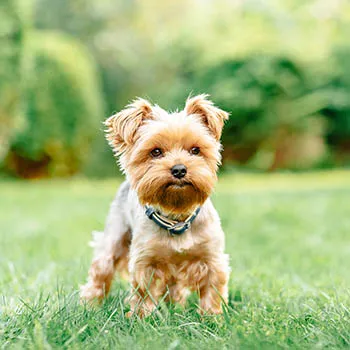In this section
A Comprehensive Guide to Understanding Small Breed Dogs

share:
When looking to adopt a dog, there are plenty of factors to consider, size being the most important. While large dogs come with protective benefits, smaller dogs make great companions. They’re lightweight, which makes it easier to pick them up and move around. They eat and shed less and also occupy less space so it is easier for them to adapt to smaller living spaces like an apartment.
The two types of smaller dog breeds are classified by their weight. Toy dogs are those that weigh less than 5 kg and include breeds such as the Miniature Dachshund, Chihuahua, Yorkshire Terrier, the Papillon, Maltese Terrie and the Pomeranian. Small dogs are classified as dogs within a weight range of 5 kg to 10 kg and include breeds as the Standard Dachshund, Jack Russell Terriers, Shih Tzu, Miniature Schnauzer, the Pug, Cavalier King Charles Spaniel, and the Shetland Sheepdog.
Although these dogs may be small in stature, they are big on attitude and energy. Here are a few characteristics to keep in mind when it comes to understanding and caring for smaller dogs…
Temperament
While temperaments are dependent on the breed, smaller dogs are generally full of energy and love playtime. They enjoy affection, love to cuddle and make for great lap dogs. They do not require too much exercise and a walk or two a day should suffice their physical needs.
Training
Since smaller dogs are less of a problem when untrained, there is a notion that they cannot or do not need to be trained. However, if left untrained, they can become feisty and difficult to handle. Some breeds are easier to train, however, some can pose quite the challenge. It is imperative for owners to be patient, firm and consistent when training their small breed dogs.
Feeding behaviour
It is important to feed these dogs energy-dense small breed dog food as their energy requirements are more than twice those of large breeds. They are however known to be very fussy and tend to leave a bit of food from their daily intake or completely refuse a meal. When it comes to dog food, they prefer small kibble dog food over large kibble. For puppies, it is important to find puppy food that contains Vitamin E for natural defence, quality protein for healthy growth and prebiotics for digestive health. Adults require food with ingredients like Sodium Tripolyphosphate (STPP) and Prebiotics (MOS) to support dental and digestive health as well as extra zinc, Omega 3 and Omega 6 to nourish healthy skin and coat. The Pedigree Pro Puppy Food and Adult Dog Food for Small Breeds are specially formulated with these ingredients to provide expert nutrition and meet the needs of small breed dogs.
Growth and lifespan
The growth period of a small breed puppy lasts for approximately 8 months, while this period is much longer for larger breeds. Their weight multiplies 20 times in their first year of life itself. Generally, smaller dogs live much longer than big dogs. The average lifespan of a small dog is 15 years whereas that of a big dog is 8 years.
Relationship with owner
Small dogs make for great cuddle buddies and are more likely to share bed/sofa space with owners thus building a strong bond between pooch and owner. Because of their small stature, owners tend to consider their small breed dogs as babies and pamper them silly. Due to the pampering, these dogs get away with a wide range of behaviours which only elevate their attitude and encourage them to believe they have a higher status in the family pack. This tendency intensifies their dominance which is why owners may be more easily manipulated by their small furry friends.
Grooming
Grooming most small breed dogs is convenient with the basic dog grooming supplies. Short-haired dogs require timely bathing, brushing, nail clipping, teeth brushing and ear cleaning. However, terriers and other breeds with long hair require a lot more attention and investment.
Disease susceptibility
Toy and small breed dogs have crowded teeth and tend to face quite a few oral health issues like tartar formation and gum recession. Smaller breeds generally live longer and hence are at a greater risk of developing periodontal disease. Periodontal disease develops when food accumulates along the gumline and becomes plaque. This plaque when combined with saliva and other minerals forms calculus. After a period of time, the calculus forms spaces under the teeth and fosters bacterial growth which leads to bone loss, tissue deterioration as well as pus formation. They are also highly susceptible to Endocardiosis (CDVD) i.e. Chronic Degenerative Valve Disease which most often leads to canine cardiac disease. Because of their sedentary lifestyle, they are also prone to obesity.
Litter size
Smaller breeds have fewer puppies (1-4) than larger breeds (6-10).
Sociability
Small breed dogs are generally social but can snap if provoked. Some breeds are not known to get along with kids or other animals, however, the majority do turn over with enough socialisation.
Small dog breeds have become increasingly popular as they make for excellent fur buddies. However, while keeping the above in mind, it is also important to gauge your living space, lifestyle and budget (for upkeep) before picking a particular breed.
Review this article:



